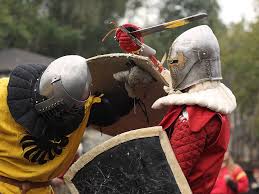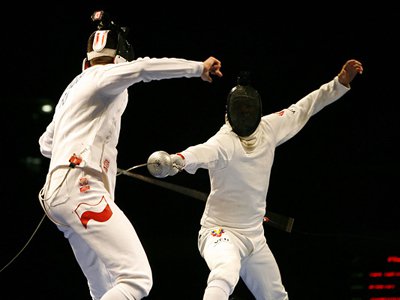FENCING DEVELOPMENT IN THE HISTORY OF ANCIENT PEOPLES
 Materials on the history of ancient peoples make it possible to say that the possession of edged weapons occupied an important place in military training and physical education of that time. The sacred books of ancient India mention the extremely basic principles of possession of edged weapons and indicate 32 types of various weapons. The teachers and distributors of fencing were apparently Indian Brahmins (clergy). Many monuments of ancient Egypt depict figures of warriors with sticks. We must think that fencing on sticks was one of the types of military training.
Materials on the history of ancient peoples make it possible to say that the possession of edged weapons occupied an important place in military training and physical education of that time. The sacred books of ancient India mention the extremely basic principles of possession of edged weapons and indicate 32 types of various weapons. The teachers and distributors of fencing were apparently Indian Brahmins (clergy). Many monuments of ancient Egypt depict figures of warriors with sticks. We must think that fencing on sticks was one of the types of military training.
The weapon consisted of a sword with a hilt, which also served to protect the hand from impact.
The sword was used primarily for attack. For protection there was a shield. Given that the weapon was heavy and difficult to control, the movements were apparently extremely elementary, and the development of equipment was reduced to training a simple, maximum impact force.
The history and literary monuments of ancient Greece make it possible to say that the possession of edged weapons was primarily of military-applied value there. However, in some cases, its use was sporty. Homer’s Illiad describes fencing competitions:
In swearing clad armor, rushing with piercing copper,
Go one on one and measure their power in front of the people.
Whoever rather pierces a noble body
And through armor it touches both the members and the scarlet blood — that is the winner.
The weapons in such hand-to-hand combat were: a spear (pike) without a tip, a blunt sword (sword), which served simultaneously for injections and punches, and a shield. The weapon technique was primitive.
Competitions were associated with the performance of cult rites. But, there are references to the use of them subsequently during the Greek games as a spectacle.
Starting from the 7th century and before the era of the decline of Greece (IV-II century BC), training was carried out mainly in special schools: Here citizens were trained to fulfill public duties and to perform military service. The ability to master weapons (sword, spear, shield) was one of the tasks of training.
A much wider use of the possession of knives, especially as a spectacle, was in ancient Rome. The main weapon of the Romans was a short, well-hardened, double-edged sword (sword). It was equally suitable for both injection and stroke. In addition, the following were used: spear, dagger and trident. For protection and partly for attack, a shield and a metal net were used.
The fencing of the Romans, according to the French fencing master Emile Merignac (The History of Fencing, Paris, 1883), consisted of “coordinating the movements of the arms and legs. The shield protected, and the sword delivered blows and injections to the appropriate target. ”
In battle, the Romans preferred an injection and mainly taught him. The ancient Roman historian Vegetius says: “Knowing how to chop and chop in the same way, the Romans easily beat their enemies, who only
chopped. ” An injection was considered more effective than a strike, because: “it is impossible to strike a chop without striking the arm and right side, while stabbing is possible without allowing the enemy to even see the movement of the sword.”
It should be noted that for the first time a correct tactical assessment of the technique of using a sword is given here. The teaching methodology is known; that the student originally practiced a wooden pole. These exercises were called batuere. Then they went on to learn how to use weapons, and strikes were made on a pillar fixed in the soil, or on a doll stuffed with straw. Finally, bilateral exercises were used with wooden swords wrapped in leather, or with spears that had a leather tip. At public games, exemplary battles of armed citizens were often arranged.
The possession of edged weapons was compulsory for young men from wealthy families. Particularly great attention was paid to this training at the age of 16-17 years, before joining the army.
“You need to wait for victory not from the number of soldiers, but from their knowledge and ability to wield weapons,” says Vegetius. So much time was devoted to training with weapons and equipment in the army that, speaking of the shield, helmet and sword (epee), Cicero1 points out: “they never served as a burden on our soldier, they did not feel more heavy from them than from their shoulders and arms and legs. ”
Particularly high was the training of fencing in gladiatorial schools.
His life depended on the ability of a gladiator to own a weapon. Therefore, the technique of possession of weapons and battle tactics were brought, for that time, to a very high degree of perfection. Apparently, elements of additional theatrical movements, required by the statute of public speaking, were introduced into the fencing technique. The sports and entertainment application of fencing had a twofold form: the battle of gladiators on blunt weapons and gladiator fights on military weapons, ending, as a rule, with the death of the vanquished,




